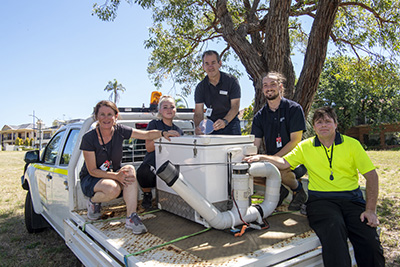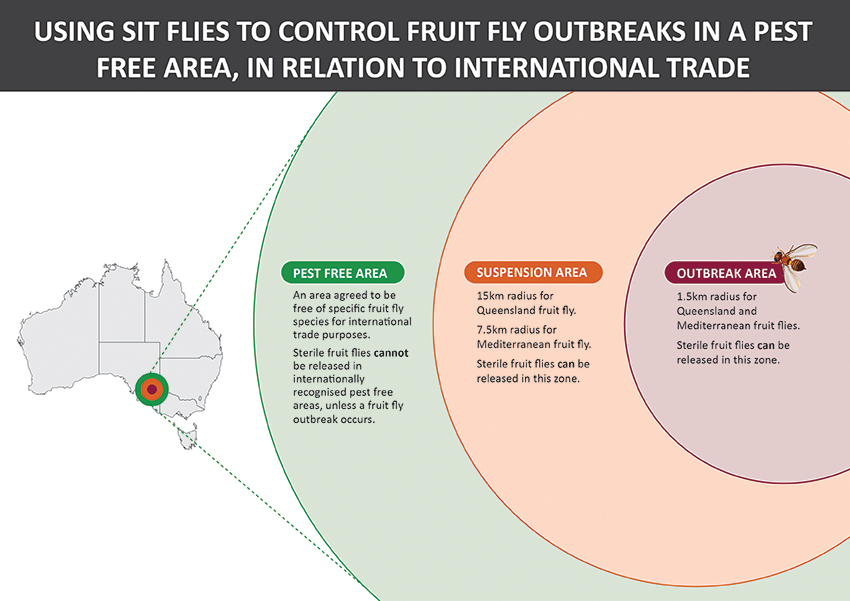What is Sterile Insect Technique?
Sterile Insect Technique (SIT) is a recognised phytosanitary procedure for pest management under the International Standards for Phytosanitary Measures (ISPMs). It is a sterilisation technique that can provide effective control of target insect populations such as fruit flies.
Method
Large numbers of sterile flies are reared to maturity before being released into the wild. The sterile flies mate with wild flies, which results in no fertile offspring. The sterile male flies outcompete the wild male flies for mating with wild females because of the large number of SIT flies that are released, leading to a reduction in fruit fly populations.
Techniques for ensuring that SIT flies can be distinguished from wild flies include marking them with dye during the rearing stage allowing for easy identification and/or for surveillance purposes. In the case where this dye is difficult to observe, there are molecular identification techniques that ensure identification.


Potential benefits
SIT is recognised as an effective and desirable option for the management and/or eradication of fruit flies. It is species-specific, environmentally friendly and has been proven effective in overseas programs such as Chile, Guatemala, Mexico, USA and Japan. SIT can contribute to:
- reduced pest damage and costs
- reduced chemical pest controls
- reduced insect and post-harvest treatment requirements and damage
- improved productivity
- improved product quality
- improved environmental outcomes.
SIT use in Australia
SIT has been previously used to control or eradicate Mediterranean fruit fly (Ceratitis capitata 'Medfly') and Queensland fruit fly (Bactrocera tryoni 'Qfly') in New South Wales (NSW), Victoria (VIC), South Australia (SA) and Western Australia (WA). It has been used successfully for suppression activities in areas of low wild fruit fly populations, and also during outbreaks within established Pest Free Areas (PFAs). In a regulated PFA, SIT flies are currently only used in response to an outbreak with the aim to eradicate the incursion.
SIT Medflies have been produced in WA since 2001 and have been effectively used to contribute to the eradication of recent outbreaks in SA. A Medfly SIT facility is in operation in south Perth and funded until the end of 2021. Currently there is a project underway to analyse and report on the costs and benefits of maintaining the facility.
SITplus, a joint venture between Hort Innovation and a number of organisations including the department, state and territory governments and universities, was established to increase capacity and efficiency in delivering SIT programs for Qfly. Research in this field includes producing male-only sterile Qflies. Achieving male-only release of SIT flies would mean a more efficient and cost-effective fight against the endemic pest.
A SIT fly facility is in operation in Port Augusta, SA, producing SIT Qflies for SIT programs, and work continues to increase and improve on SIT fly production.
Qfly © Pia Scanlon, State of Western Australia (Department of Primary Industries and Regional Development, WA) 2021
Current and next steps
The Department of Agriculture, Fisheries and Forestry in consultation with the National Fruit Fly Council (NFFC) has developed a draft Policy for Fruit Fly Sterile Technique in Relation to Trade. The policy:
- defines the contexts in which SIT releases can take place without impacting existing pest freedom claims made by Australia and recognised by our international trading partners
- provides a framework for the Australian Government to assess overseas SIT programs
- defines the roles, interactions and requirements of the governments and industry regarding SIT release where export trade is concerned.
The draft Policy was released for public consultation in December 2020 on the department's Have Your Say webpage and closed 28 March 2021. Feedback from the consultation lead to a workshop facilitated by the National Fruit Fly Council on 12 July 2021.
The workshop initiated constructive discussions on the use of SIT and the draft Policy, and the department and the NFFC continue to discuss next steps.



